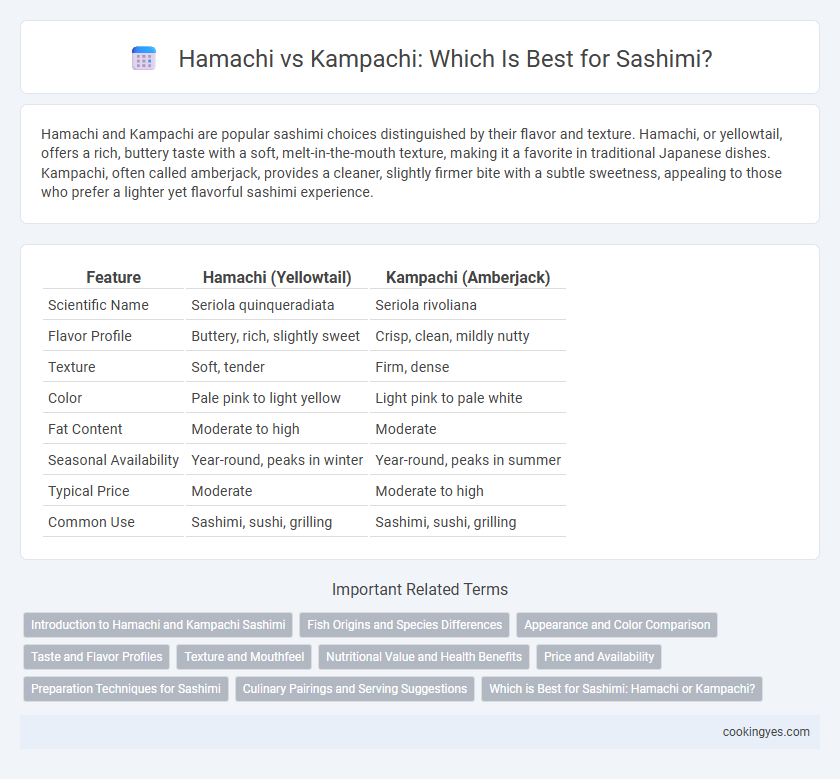Hamachi and Kampachi are popular sashimi choices distinguished by their flavor and texture. Hamachi, or yellowtail, offers a rich, buttery taste with a soft, melt-in-the-mouth texture, making it a favorite in traditional Japanese dishes. Kampachi, often called amberjack, provides a cleaner, slightly firmer bite with a subtle sweetness, appealing to those who prefer a lighter yet flavorful sashimi experience.
Table of Comparison
| Feature | Hamachi (Yellowtail) | Kampachi (Amberjack) |
|---|---|---|
| Scientific Name | Seriola quinqueradiata | Seriola rivoliana |
| Flavor Profile | Buttery, rich, slightly sweet | Crisp, clean, mildly nutty |
| Texture | Soft, tender | Firm, dense |
| Color | Pale pink to light yellow | Light pink to pale white |
| Fat Content | Moderate to high | Moderate |
| Seasonal Availability | Year-round, peaks in winter | Year-round, peaks in summer |
| Typical Price | Moderate | Moderate to high |
| Common Use | Sashimi, sushi, grilling | Sashimi, sushi, grilling |
Introduction to Hamachi and Kampachi Sashimi
Hamachi sashimi, derived from young yellowtail, features a rich, buttery texture with a slightly sweet flavor, preferred for its tender mouthfeel and vibrant taste in sushi dishes. Kampachi sashimi, sourced from the greater amberjack, offers a firm texture and a cleaner, more subtle flavor profile, appealing to those who enjoy a milder yet satisfying sashimi experience. Both fish are prized in Japanese cuisine for their distinct textures and flavors, making them versatile choices for sashimi enthusiasts seeking premium quality and freshness.
Fish Origins and Species Differences
Hamachi, also known as Japanese amberjack, originates primarily from the waters around Japan and is a species of Seriola quinqueradiata, prized for its rich, buttery texture and slightly sweet flavor. Kampachi, or Almaco jack, scientifically named Seriola rivoliana, is typically sourced from the tropical Pacific, including Hawaii, and features a firmer flesh with a more subtle taste compared to hamachi. These species differences and geographic origins influence their flavor profiles and texture, making each uniquely suited for sashimi experiences.
Appearance and Color Comparison
Hamachi sashimi features a pale pinkish-white flesh with a slightly translucent appearance, while Kampachi sashimi displays a more vibrant, creamy white color with subtle yellowish undertones. Hamachi's texture is smooth and buttery, complementing its delicate, light coloration, whereas Kampachi tends to have a firmer, denser texture that highlights its richer, more vivid hue. The distinct color contrast enhances the visual appeal on sashimi platters, making each fish recognizable by its unique shade and translucency.
Taste and Flavor Profiles
Hamachi sashimi offers a rich, buttery flavor with a smooth, creamy texture that melts in the mouth, making it a favorite for those seeking a delicate yet full-bodied taste. Kampachi sashimi presents a slightly firmer texture with a clean, crisp flavor and subtle sweetness, appealing to those who prefer a lighter, more refreshing sashimi experience. Both fish provide distinctive umami profiles but differ in fat content, with Hamachi typically richer and Kampachi more refined and nuanced.
Texture and Mouthfeel
Hamachi sashimi offers a buttery, rich texture with a tender mouthfeel that melts smoothly on the palate, while Kampachi presents a firmer, more resilient bite with a slightly oily finish enhancing its freshness. The dense flesh of Kampachi provides a satisfying chew, contrasting with Hamachi's silkier consistency that emphasizes creaminess. Both varieties deliver distinct tactile experiences, making texture and mouthfeel key factors in choosing between these premium sashimi options.
Nutritional Value and Health Benefits
Hamachi sashimi, derived from young yellowtail, offers a rich source of omega-3 fatty acids, vitamin D, and high-quality protein that supports cardiovascular health and brain function. Kampachi sashimi, harvested from adult almaco jack, contains a slightly higher concentration of healthy fats and essential amino acids, promoting anti-inflammatory benefits and muscle recovery. Both fish provide a low-calorie, nutrient-dense option ideal for maintaining a balanced diet and boosting overall wellness.
Price and Availability
Hamachi sashimi, derived from young yellowtail, is generally more affordable and widely available in sushi restaurants and fish markets across North America and Japan. Kampachi, also known as Almaco jack, commands a higher price due to its limited availability and often requires sourcing from specialized suppliers. The price difference reflects not only the rarity of Kampachi but also its distinct flavor profile, affecting accessibility for everyday sashimi consumers.
Preparation Techniques for Sashimi
Hamachi sashimi requires careful slicing against the grain to maintain its delicate, buttery texture, often served slightly chilled to enhance its rich flavor. Kampachi sashimi demands precision in removing the skin and cutting precise, thicker slices to preserve its firmer, clean taste profile. Proper knife technique and freshness of the fish are critical in both to maximize the subtle, sweet nuances characteristic of these premium sashimi varieties.
Culinary Pairings and Serving Suggestions
Hamachi sashimi offers a buttery texture and rich flavor, pairing excellently with ponzu sauce, scallions, and daikon radish to enhance its umami depth. Kampachi, known for its cleaner, more delicate taste, complements citrus-based sauces and light garnishes such as yuzu kosho or shiso leaves, balancing its subtle sweetness. Both fish benefit from serving chilled on a bed of shaved ice with wasabi and soy sauce to accentuate their distinct culinary profiles.
Which is Best for Sashimi: Hamachi or Kampachi?
Hamachi and Kampachi are both prized choices for sashimi, with Hamachi offering a rich, buttery flavor and a slightly softer texture, ideal for those who prefer a more delicate bite. Kampachi, known for its clean, mild taste and firmer flesh, delivers a refreshing and crisp sashimi experience favored by enthusiasts seeking a balanced flavor profile. The best choice ultimately depends on personal preference, whether favoring Hamachi's creamy richness or Kampachi's light, refreshing texture.
Hamachi vs Kampachi for sashimi Infographic

 cookingyes.com
cookingyes.com